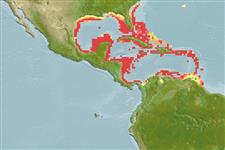Environment: milieu / climate zone / profondeur / distribution range
Écologie
marin récifal; non migrateur; profondeur 1 - 100 m (Ref. 110583), usually 15 - 55 m (Ref. 110583). Tropical; 33°N - 9°S, 98°W - 57°W
Western Atlantic: southern Florida and the western Gulf of Mexico to the West Indies-Caribbean region and Venezuela.
Taille / Poids / Âge
Maturité: Lm ? range ? - ? cm
Max length : 10.0 cm TL mâle / non sexé; (Ref. 47838)
Épines dorsales (Total) : 13 - 14; Rayons mous dorsaux (Total) : 18 - 19; Épines anales: 3; Rayons mous anaux: 14 - 16. Upper half of body yellow-orange, shading into blackish basally in dorsal fin; lower half of body white; orange bands on head and a narrow orange bar on caudal peduncle (Ref. 13442).
Body shape (shape guide): short and / or deep; Cross section: compressed.
Inhabit deep coral-rich reefs and drop-offs (Ref. 47838). Feed on small invertebrates. Often seen nibbling on the tube feet of sea urchins or the tentacles of tubeworms (Ref. 9710). Unlike some chaetodonts it does not pick parasites from the bodies of other fishes (Ref. 5521). Solitary, sometimes in pairs (Ref. 47838). Seek refuge when approached (Ref. 47838). Oviparous (Ref. 205). Form pairs during breeding (Ref. 205).
Life cycle and mating behavior
Maturité | Reproduction | Frai | Œufs | Fécondité | Larves
Form pairs during breeding (Ref. 205).
Allen, G.R., R. Steene and M. Allen, 1998. A guide to angelfishes and butterflyfishes. Odyssey Publishing/Tropical Reef Research. 250 p. (Ref. 47838)
Statut dans la liste rouge de l'IUCN (Ref. 130435: Version 2025-1)
Menace pour l'homme
Harmless
Utilisations par l'homme
Pêcheries: commercial; Aquarium: Commercial
Outils
Articles particuliers
Télécharger en XML
Sources Internet
Estimates based on models
Preferred temperature (Réf.
123201): 22.9 - 28, mean 26.5 °C (based on 234 cells).
Phylogenetic diversity index (Réf.
82804): PD
50 = 0.5001 [Uniqueness, from 0.5 = low to 2.0 = high].
Bayesian length-weight: a=0.02239 (0.01097 - 0.04568), b=3.01 (2.84 - 3.18), in cm total length, based on LWR estimates for this (Sub)family-body shape (Ref.
93245).
Niveau trophique (Réf.
69278): 3.4 ±0.2 se; based on diet studies.
Résilience (Réf.
120179): Haut, temps minimum de doublement de population inférieur à 15 mois (Preliminary K or Fecundity.).
Fishing Vulnerability (Ref.
59153): Low vulnerability (10 of 100).
🛈
Nutrients (Ref.
124155): Calcium = 146 [72, 247] mg/100g; Iron = 1.07 [0.60, 1.90] mg/100g; Protein = 18.5 [17.3, 19.8] %; Omega3 = 0.142 [0.074, 0.269] g/100g; Selenium = 45.9 [21.7, 93.2] μg/100g; VitaminA = 45.7 [12.3, 175.3] μg/100g; Zinc = 1.78 [1.15, 2.66] mg/100g (wet weight);
